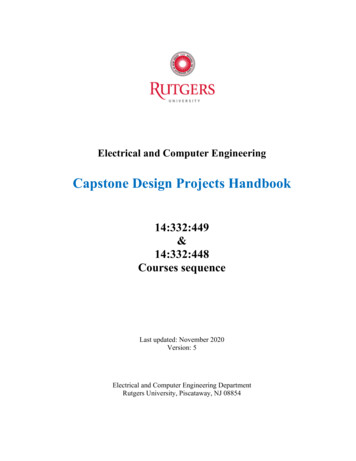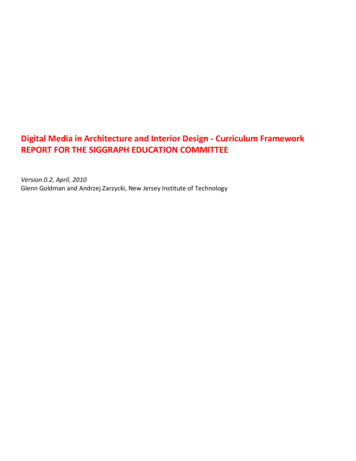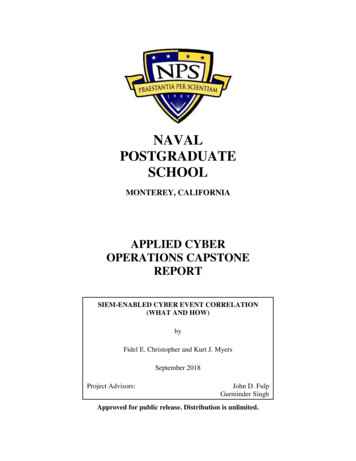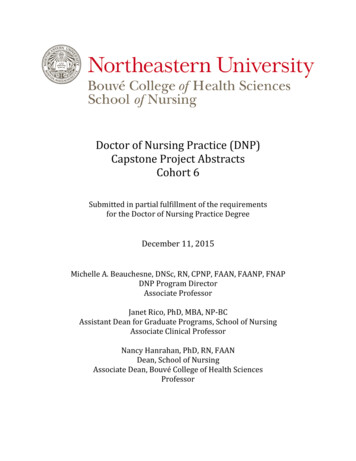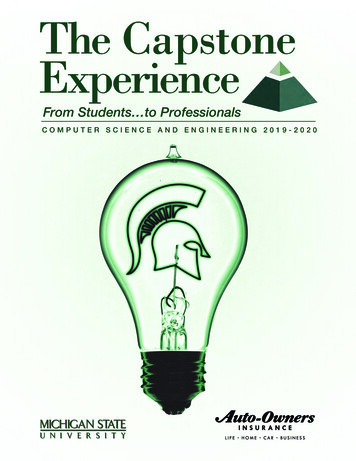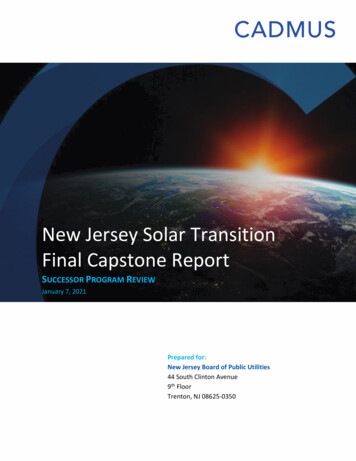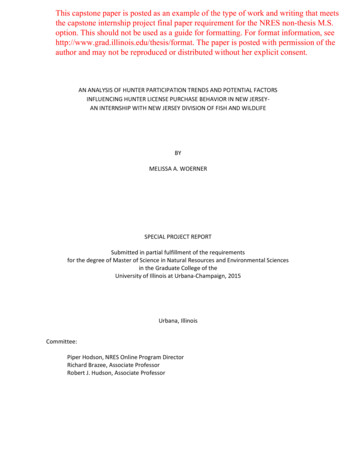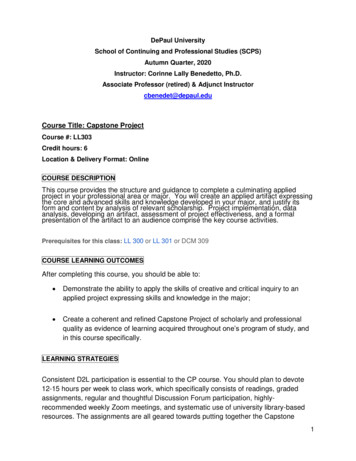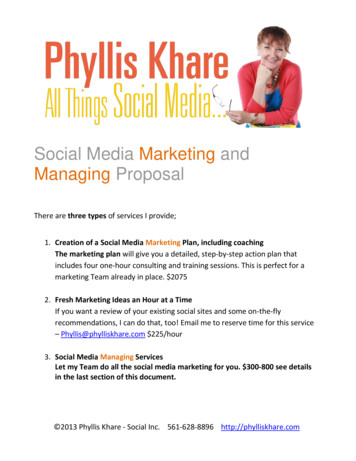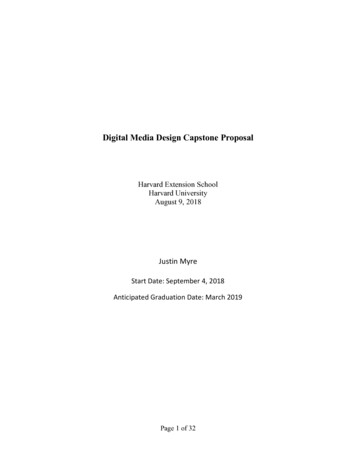
Transcription
Digital Media Design Capstone ProposalHarvard Extension SchoolHarvard UniversityAugust 9, 2018Justin MyreStart Date: September 4, 2018Anticipated Graduation Date: March 2019Page 1 of 32
1. Project Scope1.1. Tentative Project TitleTri-Cities Wine Hub1.2. Project GoalThe primary goal and underlying passion for my capstone project, Tri-Cities Wine Hub, is tocreate a community-focused, feature-rich dynamic web application for wine enthusiasts inthe Tri-Cities’ wine-growing region of Washington state (my hometown). Currently, theTri-Cities, which is located in Southeastern Washington and is comprised of the mediumsized cities of Kennewick, Richland, and Pasco, has a fairly minor internet presence withinthe wine hobbyist community and is often times overshadowed on the larger platforms bymore popular wine regions, such as California’s Napa and Sonoma valleys. I not onlyrealized this as I prepared and researched ideas for my capstone, but I also came to thisrealization as a wine tourist and enthusiast. I feel that Tri-Cities Wine Hub can address thevacuum that currently exists for what is otherwise a burgeoning and robust wine region.Tri-Cities Wine Hub will not merely be an informational website nor a wine rating webapplication but will embrace an all-encompassing approach to local wine tasting inSoutheastern Washington. Users will be able to browse local wineries that are locatedwithin an approximate driving distance of 40 miles from the Tri-Cities, they will be able tocreate a wine visitation itinerary that is configurable from a browsable and sortable winerylisting, and they will be able to maintain and customize a wine journal that can then beused for referential purposes in order to keep track of previously tasted wines.Furthermore, from the information put into their wine journals, users can optionally sharetheir own wine ratings, and browse the reviews submitted from other users. Some aspectsof the application will be for users’ personal use, such as tasting notes and itineraries, whileothers will be shareable, such as wine reviews and winery comments. Additionally, somefeatures will be fully accessible to users without logging in, such as acquiring informationabout the wineries and reading reviews, but a login will be required for more advancedfeatures like commenting or accessing the planner and journal components.There are numerous informational websites that concern wine-making and wine-tastingfrom a general perspective, such as winefolly.com, wine purchasing platforms, such aswine.com, or wine rating forums and applications, such as wines.com and the android/iOSapp Delectable, but nothing to my knowledge exists specifically for the Tri-Cities winecommunity. Where my web application idea truly excels is in its understanding andexecution of the whole wine tasting process with an integral focus on the Tri-Cities wineregion itself. Wine novices and devout enthusiasts alike, from local novices to touringaficionados, will be able to refer to Tri-Cities Wine Hub for all of their respective winehobbyist needs in this region.Page 2 of 32
1.3. Learning GoalsIn Kate Ganiukova’s article “What is a Full Stack Developer in 2018 and How Do I BecomeOne”, she thoughtfully and systematically lays out the skills, from HTML and CSS on thefrontend to database and multi-language fluency on the backend, that are not only in highdemand for web development jobs in this day and age but are also becoming increasinglynecessary.1 I fully understand that in “real-world” scenarios, when large development firmstake on large projects, most web development tasks are compartmentalized and delegatedto specific team members who specialize in particular areas. This approach promotesefficiency. Designers design and may never have to use anything more than Photoshop orIllustrator. Frontend developers deal strictly with client-side development and make sureall of the HTML and CSS assets are semantically optimized. There are even individuals whospecialize in marketing, social media, SEO (Search Engine Optimization) integration, ordatabase architecture. When I began the Digital Media Design program at Harvard,however, all I knew was that I wanted to make impactful websites, learn whatever I could,and eventually apply those skills in whatever capacity I could within the realm of webdesign and development.For my capstone I want to purposefully synthesize the classes I have taken throughout thisdiverse Digital Media Design program and apply them to one focused but well-roundedproject. I want to pay equal attention to the user interface, frontend development,information architecture, database design, and backend development while I furtherstrengthen my understanding of languages like PHP and client-side JavaScript. Tri-CitiesWine Hub will only be in its infancy when the semester concludes, as time will permit me todo only so much, but all of these areas will at least be synergized into a focused design andfinal implementation. In the end, I’m sure I will come to appreciate how all of theseelements of web development and design come together as I learn what particular areas Ihave a proclivity for and, hopefully during the process, strengthen my weaknesses. I lookforward to having the opportunity to dig deeper into the diverse areas I’ve covered throughmy coursework as I create a web application that is not only more complex than anything Ihave ever done before but is also built from the ground up.1.4. Target AudienceFirstly, it is important to address the significance of the wine industry both in Washingtonstate as a whole and the Tri-Cities area specifically, as many people outside of this regionare unaware of just how important the Tri-Cities is to the wine industry in the United Statesor the multitudes of people who visit tour region’s wineries or consume its wines.According to the Washington State Wine Commission, wine tourism generatesapproximately 4.8 billion dollars in total economic impact throughout the state ofWashington and has become the second largest producer of wine in the US.2 Furthermore,1Ganiukova, Kate. What is a Full Stack Developer in 2018 and How to Become One. Retrieved 2Washington State Wine Commission. Washington State Wine Fast Facts. Retrieved stats/state-factsPage 3 of 32
in Benton County, where the Tri-Cities is the county’s predominant metro area with anurban population of over 250,000 people, local wineries “produced just under 9.5 millioncases of wine in 2014”, which is the most in any Washington county by over 7 millioncases.3 Moreover, Visit Tri-Cities claims that over 99% of the grapes used for wine-makingin Washington state come from the Columbia Valley AVA, which not only encompasses theentirety of the Tri-Cities, but swathes of surrounding rural areas in adjacent counties.There are several other notable American Viticultural Areas near the Tri-Cities as well.Although it is difficult to ascertain how many wine tourists, consisting of both local wineenthusiasts and visiting tourists, frequent Tri-Cities wineries, it is safe to say that uniquevisitors can be accounted for in the tens of thousands on an annual basis. The Tri-CitiesWine Society, which hosts the annual Tri-Cities Wine Festival, states that there were over1000 visitors in attendance at the festival’s Gala Tasting just last year.4 Keeping in mindthat this is just a singular wine-tasting event and that there are numerous others in anygiven year, such as the spring barrel tasting held annually every April throughout theregion, suffice it to say that Tri-Cities Wine Hub could potentially have a broad andcompelling appeal. Tri-Cities Wine Hub will draw much of its user-base from the region’swine enthusiasts, ranging from novices to bona fide connoisseurs, who regularlyparticipate in wine-tasting events and visit the 200 tasting rooms that this area offers.There are three kinds of users that Tri-Cities Wine Hub can cater to, and each category ofuser has specific needs that may or may not overlap the needs of other users.User 1: Wine NoviceThis kind of user is a person who is either starting out in the wine-tasting hobby or is stillin the process of acquiring information and learning about it. The user may not even beaware that the Tri-Cities area has so many wineries and tasting rooms that offer a winetasting and touring experience. The user might just want to browse information withoutputting effort into creating an account, reviewing wines, or participating in a forum of anykind. For these reasons, certain parts of Tri-Cities Wine Hub will always be accessiblewithout a login account, such as the Winery Guide or AVA Map features, which will allowusers to search for and read up on the local wineries. They won’t be able to interact withthe information, such as favorite a winery or add comments, but at least they can view thepertinent information. Users in this category might also just want to purchase a wine for anevent, like a wedding or birthday party, and Tri-Cities Wine Hub’s community-generatedwine reviews will be accessible and searchable.User 2: Local Wine EnthusiastThis category of user regularly enjoys wine and always looks forward to the opportunity togo wine-tasting and tour the local region. They may not venture far, but at least they get outto the wineries on occasion. In this case, the user might want more dynamic features, suchWashington State Wine Commission. Economic and Fiscal Impacts of Wine & Wine Grapes in WashingtonState. Retrieved from https://www.washingtonwine.org/.4 Retrieved from www.tricitieswinesociety.com.3Page 4 of 32
as the ability to plan an itinerary or keep track of previously tasted wines. A certain amountof time may have passed to where they can’t remember what wines they really enjoyed orwhat winery they went to last. The Wine Journal and Planner features of Tri-Cities WineHub will certainly satisfy these users’ needs, but a login and password will be required.User 3: Avid Wine Tourist & ReviewerThis user category is filled with the kinds of wine enthusiasts who live, sleep and breathewine. They go on wine tours regularly, have filled their cellars with too many bottles ofwine to count, and get calls from friends and family members asking them what wineshould be paired with what entrée. I doubt any information contained on Tri-Cities WineHub would teach these users anything they haven’t heard of before. Maybe they’ve evenexhausted the hundreds of tasting rooms in Washington state. However, every communityneeds their leaders, and these are the types of users who would review the most wines,give informative winery comments, and actively give suggestions to the web admin(namely, me) for the inclusion of lesser known wineries.1.5. Elevator PitchTri-Cities Wine Hub has significant potential to impact the wine tourism and tastingindustry in the Tri-Cities by becoming a community platform for wine enthusiasts of allexperiences who already actively participate in or want to participate in this region’s winetasting. Although there are many wine tasting applications that Tri-Cities wine enthusiastscan use, and there are easily accessible resources that provide information about theregion’s wines and wineries, nothing truly exists as a “hub” to bring all these elementstogether for this specific wine region in a simplified, cohesive, accessible and feature-richapplication. By utilizing a streamlined user interface, Tri-Cities Wine Hub can be the go-towebsite application for both local and visiting wine tourists who prefer to have all of theseapplication features and informational resources in one manageable website. By creatingsynergy from my coursework at Harvard, from backend application development tofrontend design, I can bring this project to fruition.1.6. MetricsI had originally outlined three levels of success for Tri-Cities Wine Hub where each levelcorresponded to the functionality and integration of the features I have planned for thefinalized version of the application. However, I have scratched that idea in favor of aimingtoward certain quantifiable measures of success with my timeline based around thecompletion of the capstone. The deadline and time limitation are fairly obvious – the end ofthe semester – but these metrics will keep me on track throughout the semester as Isequentially integrate the various components of the application.Firstly, from a technical standpoint, all HTML and CSS must validate. That means 0 errors(unless they are associated with the front-end framework and not my own code). HTMLerror checks will be conducted at https://validator.w3.org/nu/ and CSS tests athttps://jigsaw.w3.org/css-validator/ . As I buildup the frontend of the site, I will repeatedlyconduct the tests and correct any resulting errors.Page 5 of 32
Secondly, all form inputs must validate properly. I will encourage all test users to input asmuch garbage as they can think of and try to break the forms (like putting numbers whereonly letters should go, or inputting a 20-character long phone numbers, or a 500-characterstring of code for a name field). Again, I want 100% validation.Lastly, from the technical side of things, the server must load each webpage in less than 3seconds. This will ensure that my database tables are being queried properly and withoutredundancy and my backend processes are optimized. Ultimately, this kind optimizationwill greatly benefit the users as well.Most importantly, for more user-focused metrics, I will have a survey adapted from theWebsite Usability Scale (WUS) accessible on Tri-Cities Wine Hub during the usability testingphase. This is a standardized scale that gauges how user-friendly a website is based on tensimple questions and the aggregate score of the users’ responses (either strongly disagree,disagree, neutral, agree or strongly agree). A score of 1
specialize in marketing, social media, SEO (Search Engine Optimization) integration, or database architecture. When I began the Digital Media Design program at Harvard, however, all I knew was that I wanted to make impactful websites, learn whatever I could, and eventually apply those skills in whatever capacity I could within the realm of web
